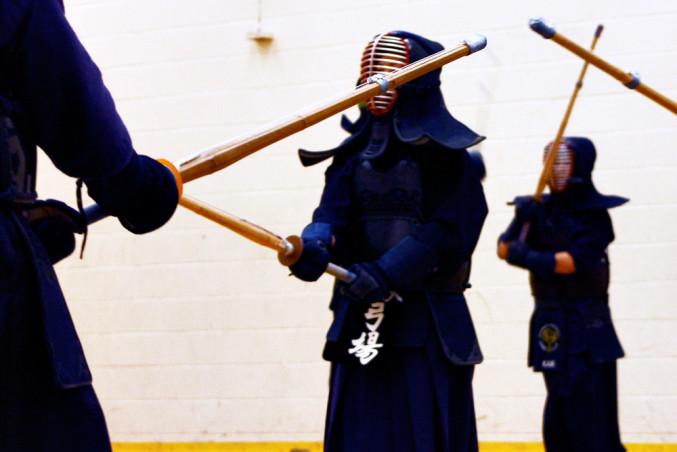By Luc Rinaldi
On Sunday mornings, Kerr Hall’s lower gym turns into a dojo. Students bow as they enter, lining up their shoes and socks in two neat rows by the door. Barefoot and robed, they reverently set down their shinai – sword-like sticks made from bamboo – and begin chanting in unison as they warm up.
The group of nearly two dozen begins practicing strike footwork in pairs, dancing delicately forward and back with intense concentration. A sensei squats meditatively against a blue and gold backdrop, observing the training, equal parts physical and spiritual.
Before long, the more experienced members of the group don their bogu – a set of armour comprised of a helmet, breastplate, waist protector and pair of gauntlets. Then, with a sharp, unannounced cry, what began like a humble Sunday service suddenly turns into a mêlée.
The gym echoes with the shrillest shrieks of battle as two members begin sparring, shuffling quickly and striking each other’s heads and wrists.
Soon the rest of the group joins in. From the sound, passersby might envision a bloodbath or warzone.
And while there aren’t any casualties, that guess isn’t far off. Kendo, the “way of the sword,” is a Japanese sword-fighting martial art rooted in the craft of the country’s most renowned warriors, the samurai.
Founded five years ago by thenurban planning student Omer Hussain, the Ryerson Kendo Club is the university’s very own league of modern samurai. What was once a five-person function has grown into a 35-member co-ed club that welcomes student, alumni and nonstudent practitioners from across the city.
“Kendo means more to me than just repetition of swinging a stick up and down,” says Hussain, a 2009 Ryerson graduate who continues to take a leading role in the club.
A longtime martial artist, he explains that kendo is both a sport and way of life. While its objective is to hit an opponent’s head, chest, wrists or neck, kendo is less about ruthless attacking and more a technical discipline of concentrating one’s energy into each individual strike. Its dominant principle is ki ken tai – spirit, sword and body.
“All these things have to come together in one motion,” Hussain says. “Kendo’s very deep, but it takes time.”
For many, the club is students’ first exposure to kendo. Kexin Zhang, a first-year interior design student, originally joined the club because of her interest in Japanese culture, but stuck around because of the sport’s more calming qualities.
“You have to forget about everything else and immerse yourself into it,” she says. “It’s a moment where you can relax and forget about all the stress that’s bothering you.” Kendo is about mental awareness,” says Mike McCulloch, a senior student who occasionally leads practices for the club’s beginners.
“It’s about knowing yourself, knowing your capabilities and knowing your opponent and anticipating what they’re going to do. It’s kind of like a mental chess game.”
And like chess, kendo has its requisite pieces – albeit more expensive ones. A shinai costs about $50 and will last several months, while proper bogu can run anywhere from $500 to $1,000. Beginners, however, don’t require armour and can try the club for free before having to pay a membership fee. The open invitation is part of Hussain’s vision for the club. He explains that kendo is a historic art that anyone should be able to participate in.
Back in the gym, the beginners’ practice has ended. Only a few of the younger students remain, seated at the far end of the gym, intently studying the more seasoned members as they continue to spar, still yelling with the same vigour and volume as before.
Among the spectators is Matthew Lum, a first-year engineering student.
“Immediately, there’s this respect that everyone gives each other,” he says, explaining the appeal of the club.
Looking on, he hopes to soon be among those he’s watching. But like Hussain, he knows: kendo takes time.










Leave a Reply